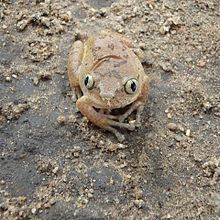Broadley's forest tree frog
| Broadley's forest tree frog | |
|---|---|

| |
| Scientific classification | |
| Domain: | Eukaryota |
| Kingdom: | Animalia |
| Phylum: | Chordata |
| Class: | Amphibia |
| Order: | Anura |
| Family: | Arthroleptidae |
| Genus: | Leptopelis |
| Species: | L. broadleyi
|
| Binomial name | |
| Leptopelis broadleyi Poynton, 1985
| |
| Synonyms[1] | |
|
Leptopelis argenteus meridionalis Schiøtz, 1975 | |
Leptopelis broadleyi (Broadley's forest tree frog) is a species of frog in the family Arthroleptidae of uncertain status. The Amphibian Species of the World,[1] the IUCN SSC Amphibian Specialist Group,[2] and the African Amphibians do not recognize it,[3] but instead consider it synonym with Leptopelis argenteus.[2][1] (ASW expresses some hesitation though.[1]) However, the AmphibiaWeb recognizes it as a valid species.[4]
Distribution[edit]
Leptopelis broadleyi is found in Malawi, Mozambique, and Zimbabwe.[4]
Habitat and conservation[edit]
This species occurs in forest-savanna mosaic and along forested streams through savanna.[4]
Leptopelis broadleyi was assessed in 2004 by the International Union for Conservation of Nature (IUCN) as being of "Least Concern";[5] in the 2016 assessment, it was brought into synonymy with Leptopelis argenteus.[2]
References[edit]
- ^ a b c d Frost, Darrel R. (2016). "Leptopelis argenteus (Pfeffer, 1893)". Amphibian Species of the World: an Online Reference. Version 6.0. American Museum of Natural History. Retrieved 14 January 2017.
- ^ a b c IUCN SSC Amphibian Specialist Group (2016). "Leptopelis argenteus". IUCN Red List of Threatened Species. 2016: e.T88340714A18385796. doi:10.2305/IUCN.UK.2016-1.RLTS.T88340714A18385796.en. Retrieved 20 November 2021.
- ^ "Leptopelis Günther, 1859". African Amphibians. Retrieved 14 January 2017.
- ^ a b c "Leptopelis broadleyi". AmphibiaWeb. University of California, Berkeley. 2008. Retrieved 14 January 2017.
- ^ John Poynton; Arne Schiøtz (2004). "Leptopelis broadleyi". IUCN Red List of Threatened Species. 2004. Archived from the original on 24 October 2012. Retrieved 14 January 2017.
